This essay provides a brief explanation of
the open hand hits pertaining to the older la savate and Defense Dans
La Rue systems.
“Even if the hand is used for war like purposes, it is in ninety- nine cases out of every one hundred used with the fingers open”
- E.B.Michell, English boxing professor and author, 1889.
By the late 1700s, Frenchmen were settling
arguments by using a Parisian form of boot fighting which came to called
la savate. A colloquial word meaning shoe la savate was often
associated with the delivery of the “Coup De Grace” or “finishing blow”
in a street confrontation. Renowned as a simple but brutally effective
system of street combat its emphasis was not to engage the opponent for
long periods of time, but to terminate the confrontation in the quickest
possible way.
Michel Pisseux, a product of this early
savate system, was born in 1794 and raised in La Courtille considered at
the time one of the roughest areas of Paris . As a young man Pisseux
would frequent various fighting districts to observe and catalogue the
most practical strikes used by the street brawler’s of the era.
Realizing that the more natural use of the
open hand as a weapon for both attack and defense along with the street
kicking skills was an inseparable foundation for many street fighters,
Pisseux would adopt these same techniques into his own personal system
of savate. The influence of these open hand skills was reflected in
Michel’s “La savate guard” (picture –1). Resembling the passive guards
made popular by today’s reality based fighting systems the hands were
held open in front of the body in a non-aggressive posture, the enemy
was never sure if the savateur would make an attack or stand down.
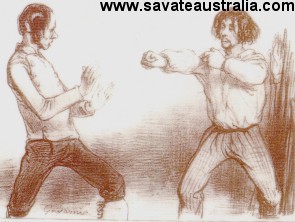
Although we do not know who Michel’s
instructor was, or if he even had one, we do know that by the 1820s he
had opened his own salle where he provided tuition in several French
combat disciplines. These disciplines including la savate, la canne and
baton, his clientele would come to include such aristocrats as Lord
Seymour and the Duke of Orleans.
Grouping his savate skills into 15 divisions
of la canne and 15 divisions of street kicking techniques Pisseux’s
approach to savate would later be documented in a small booklet entitled
“La Art De La Savate et De La Canne”.
LA MUSETTE
Several of the names used to describe the
hand techniques of la savate are idiomatic expressions that have all but
faded into obscurity. The word musette meaning “horses feed bag” is
perhaps savate’s most powerful of all open hand strikes. Delivered in an
upward or linear trajectory the palm of the hand was used to strike the
adversary’s chin, nose or – “feedbag”. When thrown from Pisseux’s la
savate guard the musette traveled below the opponent’s visuals often
catching him totally unaware.
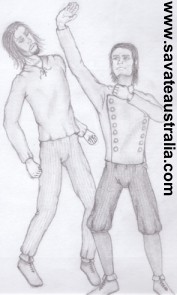
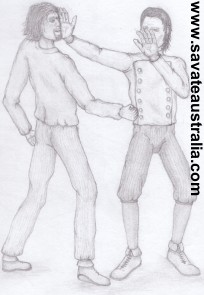
PIQUE
The use of the fingers to attack the
adversary’s eyes could be used simultaneously with a variety of open
hand blows, and required little power to produce disabling results.

LA BAFFE
La Baffe means to “clout” someone across the face, head or neck. This blow was delivered with the palm of the hand in a horizontal or oblique plan. The hand configuration used when throwing la baffe consisted of a broad or flattened palm , which covers a wider area of impact.
LE REVERS DE BAFFE
A variation of la baffe was a backhand strike called – ‘le revers de baffe. Often delivered in a horizontal or oblique plan, the neck could be targeted to create a brachial stun. A quick back hand flick to the eyes was enough to cause pain and obscure the adversary’ visuals opening him up to more substantial blows. Should the hands be positioned into the front or side trouser pockets a backhand slap to the groin was also possible.
A ploy favored by the French Apaches was to lull the intended victim into a false sense of security with idle talk while holding both hands in their front pockets. From this position the hoodlum would suddenly attack with a backhand slap up into the face. This was followed immediately with a head but into the groin or stomach region and a double leg pick up, dumping the victim onto his back.
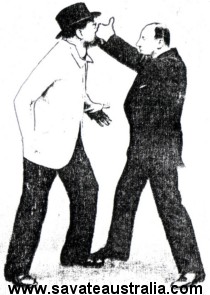
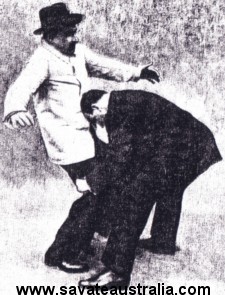
LE TRANCH
Tranche, meaning to chop, is an effective edge of hand blow taken from Jiu-jitsu and adopted into the French –“ Defense Dan’s La Rue” systems during the early 1900s.
Delivered along multiple trajectories many practitioners favored the traditional hand configuration with the fingers adducted and the thumb extended out to the side. Perhaps the most versatile of all open hand hits, la tranche could strike various targets from a multitude of positions either on its own or in conjunction with other hand techniques.
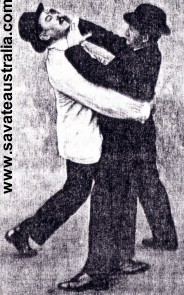
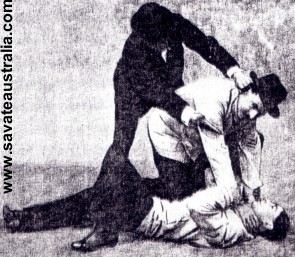
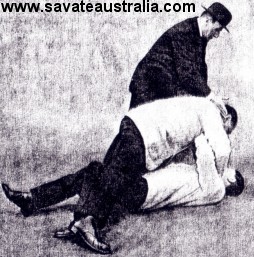
For those who may deem open hand techniques
as unusual, primitive or even crude it should be taken into
consideration that few people are able to use the fist naturally without
prior training. Even with extensive training hand blows using the
knuckles are prone to damage when impacting hard skeletal structures
such as the cranium or mandible.
La Savate instructors like Michel Pisseux knew that open hand blows were tried and true methods, and to this very day there principles remain tactically correct for use in personal combat.
Bibliography
Charlemont J . L’ Art De La Boxe Boxe “>Francaise Et De La Canne. Paris : A ‘L ‘ Academie De Boxe ,24, Rue Des Martyrs 1899.
Traite De Canne, Boxe et Baton Theorie Et Exercices. Paris : Delarue, Libraire – Editeur.
Formation La Savate. Paris : FFBFS DA 1998.
Roubaud. E. & De Lolme and Wallace. A French and English Dictionary, compiled from the best authorities of both languages. Paris , London , New York & Melbourne : Cassel & Company , Limited 1900.
Dubois Georges. Comment Se Defendre. Paris : Bibliotheque Sportive Nilsson 1916.
E.B. Michell, Armstrong Walter , Pollock H. Walter, Grove C. F and Camille Prevost , Maitre D’Armes. Fencing ,Boxing Wrestling. London : Spottiswoode and CO 1889.
NOTES
This essay "Open Hands" is by Craig Gemeiner © 2004. My deepest gratitude to Craig Gemeiner for his kind permission in reposting his essay to my site. Contents cannot be copied, republished or transmitted without prior consent from him. Copied from http://savateaustralia.wordpress.com/essays/open-hands/
Craig Gemeiner specializes in the study of traditional Western fighting arts, particularly Savate and its associated disciplines, and adapting them to modern use. He is one of few instructors in the world teaching ‘Defense dans la Rue’ , a system of self-defense developed in Paris during the late 1800s and has given seminars in Australia, Japan, USA, New Zealand and Italy. For an expanded background on his background, please check out: http://gemeineracademy.wordpress.com/about-us/about-craig-gemeiner/
and his various sites below:
http://www.savateaustralia.com/
http://lacannevigny.wordpress.com/
http://defensedanslarue.wordpress.com/
http://www.freewebstore.org/bootfightercatalogue/index.aspx?pageid=1000146
http://bootfighter.wordpress.com/
http://gemeineracademy.wordpress.com/













0 comments:
Post a Comment